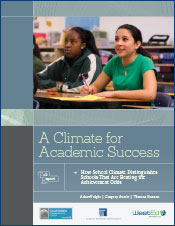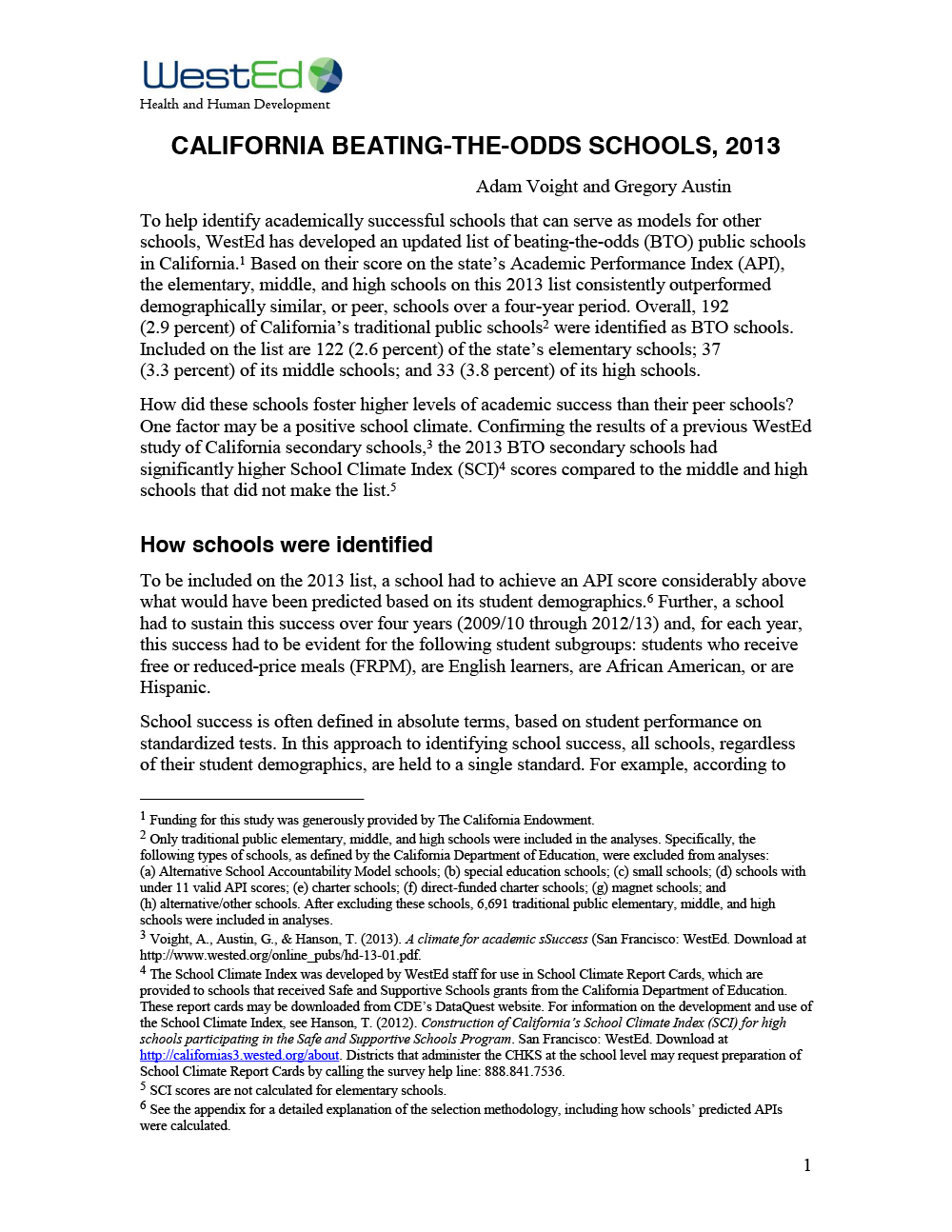How Campus Climate Can Help Schools Beat the Odds
Posted on

On her first day as assistant principal 10 years ago, Terry Ceja walked through the door and caught sight of a disconcerting line snaking down the hallway: 150 students standing in a tardy line — a line that took two to three hours to process each morning.
This was Sierra Vista Middle School in La Puente, California, about 20 miles east of downtown Los Angeles. The school has the highest foster, homeless, and gang-related student demographic in the Hacienda La Puente Unified School District — where lunchtime was “punch time” most days of the week and the administration processed about 30 discipline referrals from teachers each day.
When Ceja arrived, the school was struggling with academic achievement, and she and the school’s then-principal, Sue Kaiser, knew major changes were needed to turn things around. With previous experience in a variety of educational roles, they had a good idea of what to do first.
“We had learned what was often missing in lower-performing schools were strong relationships that fostered a supportive school environment and a sense of pride in the school,” she says. “Our vision was for kids, and teachers, to have the best six hours of their day at Sierra Vista.”
Ceja and Kaiser embraced the goal of improving school climate as a way for Sierra Vista to move forward. This explicit focus on strengthening relationships between students and staff, fostering a safer and more supportive campus, and setting high expectations for all students helped transform Sierra Vista into a school that “beat the odds” — performing better than expected on standardized tests, given the characteristics of the students it serves.
Study findings: Climate really matters
A study from WestEd suggests that Ceja and Kaiser set Sierra Vista on the right track. A Climate for Academic Success: How School Climate Distinguishes Schools That Are Beating the Achievement Odds provides evidence that schools like Sierra Vista need not be an anomaly — that school climate can make a very big difference, particularly on student academic achievement.
Using publicly available academic performance and demographic data from the California Department of Education (CDE), WestEd identified 40 “beating-the-odds” (BTO) schools — defined by the study as those substantially outperforming demographically similar schools over a multiyear period — from among more than 1,700 California public middle and high schools. While the WestEd team expected a relationship between achievement and campus climate, they were surprised by the magnitude of difference in School Climate Index scores between non-BTO schools and BTO schools. On average, non-BTO schools were at the 49th percentile for positive school climate, while BTO schools were at the 82nd percentile. Further, the difference in average School Climate Index scores was twice as large between BTO schools and 20 schools that consistently underperformed.
In fact, school climate was found to be a defining characteristic of BTO schools: it differentiated more strongly between non-BTO and BTO schools than student demographics or personnel resources, such as the education and experience of staff. In other words, in two schools with identical resources or demographics, the school with a better climate was far more likely to be academically successful.
“Many education outcomes are associated with factors that are difficult or impossible to change, like socioeconomic status and ethnicity or race,” says lead author Adam Voight, a Research Associate in WestEd’s Health & Justice Program. “The findings of this study don’t suggest otherwise. But the study does suggest that improving school climate may bring positive results; it offers another way to tackle issues related to poor academic achievement, particularly in schools whose students are predominantly low-income.”
WestEd and California: In sync on school climate
WestEd’s HHD Program has long recognized the importance of school climate and safety. With funding from the CDE, WestEd developed and administers the California Healthy Kids Survey (CHKS), the oldest and largest statewide student survey of resiliency, protective factors, and risk behaviors in the nation. The CHKS — which now has companion staff and parent surveys that collectively make up the California School Climate, Health, and Learning Survey System (CalSCHLS) — includes measures of school environment such as safety, academic supports, social relationships, and school connectedness, which result in data that schools can use to target strategic areas for improvement.
WestEd also provides climate-related technical assistance to schools and districts, including high schools in California, Louisiana, and South Carolina that received federally funded Safe and Supportive Schools (S3) grants. In California, after two years of implementing their S3 grant programs with assistance from WestEd, 86 percent of these schools had improved their school climate. On average, the S3 schools in California also saw an increase of 15 points in their Academic Performance Index (API), an annual measure of school and district performance on standardized tests.
“Social and emotional facets of the school experience are often left out when people are discussing hard outcomes, like test scores,” says Voight. “But it’s critical to address underlying issues that prevent students from being socially and emotionally ready to learn and achieve at a high level.”
Failure to include school climate may account for why so many improvement efforts fall short and test scores plateau, said Greg Austin, WestEd’s HHD Program Director, in a recent presentation given at the White House.
Now, adds Voight there’s validation at the state level for the importance of school climate: “For the first time ever, school climate is explicitly being included in how California thinks about assessing school and district performance.”
California now requires districts to develop an annual Local Control and Accountability Plan (LCAP) for meeting annual goals for all of their students, particularly those who are struggling most. The plan has to be aligned with eight state priority areas — one of which is school climate. “California is leading the way in this respect,” says Austin, adding that WestEd helps by consulting with districts on LCAP development to strengthen school climate.
Fostering a positive school climate
While WestEd’s study showed that positive school climate is a common characteristic among all beating-the-odds schools, it didn’t specifically explore how BTO schools are fostering those supportive environments. However, feedback collected from S3 schools indicates that a schoolwide commitment to improving campus climate — together with parent and community engagement — is critical to success. Important also are developing and implementing targeted interventions informed by the school climate data.
Improvements, says Voight, depend on laying a strong foundation of developmental supports that research has shown to mitigate risk factors. These supports include caring adult relationships, high expectations, meaningful participation by students, and increased student perception of safety.
Sierra Vista Middle School provides a case study of implementing school climate improvement strategies that result in significant improvements. Even without the benefit of S3 grants or federal programs, Sierra Vista has had high ratings on the CalSCHLS surveys from both students and teachers for several years running. A school whose student body is 98 percent racial/ethnic minorities and 98 percent eligible for free and reduced-price lunch, Sierra Vista has also increased its API scores from 678 ten years ago to 810 — including the highest API gain in its district last year.
When Ceja, who is now the principal at Sierra Vista, came on board, she started by collaborating with the teachers to address campus climate: improving the physical environment of the staff lounge, organizing and cooking for regular social gatherings, and cultivating a sense of trust and unity among the staff and administration. In addition, a four-step, schoolwide behavior management system transformed discipline from an act of blame to a process of helping students adjust their behavior so they can stay in class or get back to class and participate. As part of this system, teachers stand near the doorway and greet every child by name at the beginning of every period.
Despite initial strong resistance, establishing a dress code helped remove visual cues of differences between students, which had sparked many earlier confrontations. “I’d say that eliminated about 20 percent of the problem,” says Ceja, who shares some common history with many of her students, having crossed the U.S. border from Mexico at age eight.
The administrators and staff at Sierra Vista have employed a wide range of other strategies to build not only relationships, but also structures, like the behavior management system, and high expectations. These innovations include the inauguration of a “Fun Friday” at the end of every grading period, a reward in which students with high grades in citizenship get to choose a fun activity like dance class, art class, or basketball.
“Sierra Vista has become a training ground for other schools looking to improve their school climate and student achievement,” says Austin. “And its success shows that progress can be made without major financial investments, just by focusing on climate and culture.”
Last year, administrators and leadership teams from 28 schools both inside and outside the district — including schools with much higher API scores — came to see what they could learn from Sierra Vista. Many were dubious at first, said Ceja, expecting to see computers and fancy technology behind the improvements. “But it doesn’t take expensive equipment to do what’s best for our kids,” she says. “A great relationship costs nothing but accomplishes much.”
The research study reported here was supported by the California Comprehensive Center through funding from the U.S. Department of Education.
This article was originally posted on January 20, 2015.



